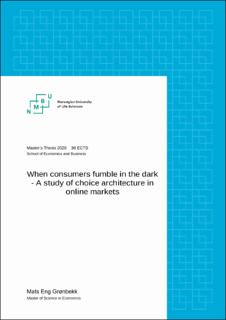| dc.contributor.advisor | Alfnes, Frode | |
| dc.contributor.author | Grønbekk, Mats Eng | |
| dc.coverage.spatial | Norway | en_US |
| dc.date.accessioned | 2020-09-30T13:20:19Z | |
| dc.date.available | 2020-09-30T13:20:19Z | |
| dc.date.issued | 2020 | |
| dc.identifier.uri | https://hdl.handle.net/11250/2680583 | |
| dc.description.abstract | Nudging has in recent years established itself as a useful tool for influencing people's behaviour and is today widely used by governments around the world. Although the use of government nudging has grown sharply in recent times, nudging as a measure has long been used by commercial agents. The most significant difference between government and commercial agents when it comes to nudging, is their underlying intentions. While the government wants to improve the lives of its citizens, the commercial agent usually put profits before other factors. Considering that commercial agents who now operate digitally have more tools available than ever before which they can use to nudge, implies that they have more opportunities to influence consumers.
The purpose of this study is to examine how online retailers use choice architecture and knowledge about consumer behaviour to nudge their customers. The problem is mainly answered through a qualitative content analysis of three large Norwegian webstores conducted in real time. The qualitative content analysis is complemented by a quantitative analysis of the results. The literature for the study is based on theories of purchase behaviour, limited rationality, and choice architecture.
The results show that webstores’ use of choice architecture is complex. Some types of choice architecture are more common than others, such as measures that simplify product information and the choice structure. Other measures however are less common, such as e.g. the use of decision-making tools in the form of comparison tools. On a general basis, the study found that webstores where the products have a greater degree of complexity also use more choice architecture. This suggests that these webstores are doing more to simplify the decision process for their customers. In addition, the results showed that two types of choice architecture are mainly used: the one that aims to simplify the decision process (good nudges) and the one whose purpose is only to increase the profits of the webstores (bad nudges).
Essentially, the webstores make use of good nudges which aim to simplify the decision process for the customers, while at the same time leading to increased profits for the retailer. Nevertheless, there is also a significant use of bad nudges, which only benefits the retailer. Considering that digital tools are becoming more and more sophisticated as time goes on, my recommendation is that consumer authorities should keep a close eye on online markets in the future. In doing so, they can ensure that marketing legislation keeps pace with changes in the market and ensure that consumers are not exploited excessively. | en_US |
| dc.description.abstract | «Dulting» har de senere årene etablert seg som et nyttig hjelpemiddel for å påvirke folks atferd, og benyttes i dag flittig av myndigheter verden over. På tross av at bruken blant myndigheter har vokst kraftig i nyere tid, har dulting lenge vært anvendt av kommersielle aktører. Den største forskjellen på myndigheter og kommersielle aktører når det kommer til dulting, er de bakenforliggende intensjonene. Mens myndighetene ønsker å forbedre folks liv, setter de kommersielle aktørene som regel profitt foran andre faktorer. Gitt at kommersielle aktører som i dag opererer digitalt har flere verktøy tilgjengelig enn tidligere som de kan bruke til dulting, åpner dette for enda flere muligheter til kundepåvirkning.
Formålet med denne studien er å kartlegge hvordan nettbutikker bruker valgarkitektur og kunnskap om forbrukeratferd til å dulte kundene sine. Problemstillingen er i hovedsak besvart gjennom en kvalitativ innholdsanalyse av tre store norske nettbutikker utført i sanntid. Den kvalitative innholdsanalysen suppleres av en kvantitativ analyse av resultatene. Litteraturgrunnlaget for studien baserer seg på teorier om kjøpsatferd, begrenset rasjonalitet og valgarkitektur. | en_US |
| dc.language.iso | eng | en_US |
| dc.publisher | Norwegian University of Life Sciences, Ås | en_US |
| dc.rights | Navngivelse 4.0 Internasjonal | * |
| dc.rights.uri | http://creativecommons.org/licenses/by/4.0/deed.no | * |
| dc.subject | Nudge | en_US |
| dc.title | When consumers fumble in the dark : a study of choice architecture in online markets | en_US |
| dc.type | Master thesis | en_US |
| dc.description.version | submittedVersion | en_US |
| dc.source.pagenumber | 87 | en_US |
| dc.description.localcode | M-ECON | en_US |

